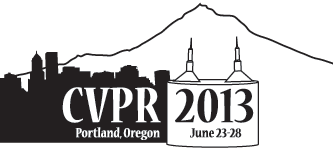-
Learning a Manifold as an Atlas
AbstractIn this work, we return to the underlying mathematical definition of a manifold and directly characterise learning a manifold as finding an atlas, or a set of overlapping charts, that accurately describe local structure. We formulate the problem of learning the manifold as an optimisation that simultaneously refines the continuous parameters defining the charts, and the discrete assignment of points to charts. In contrast to existing methods, this direct formulation of a manifold does not require "unwrapping" the manifold into a lower dimensional space and allows us to learn closed manifolds of interest to vision, such as those corresponding to gait cycles or camera pose. We report state-ofthe-art results for manifold based nearest neighbour classification on vision datasets, and show how the same techniques can be applied to the 3D reconstruction of human motion from a single image.
Related Material
[pdf][bibtex]@InProceedings{Pitelis_2013_CVPR,
author = {Pitelis, Nikolaos and Russell, Chris and Agapito, Lourdes},
title = {Learning a Manifold as an Atlas},
booktitle = {Proceedings of the IEEE Conference on Computer Vision and Pattern Recognition (CVPR)},
month = {June},
year = {2013}
}
These CVPR 2013 papers are the Open Access versions, provided by the Computer Vision Foundation.
Except for the watermark, they are identical to the accepted versions; the final published version of the proceedings is available on IEEE Xplore.
Except for the watermark, they are identical to the accepted versions; the final published version of the proceedings is available on IEEE Xplore.
This material is presented to ensure timely dissemination of scholarly and technical work.
Copyright and all rights therein are retained by authors or by other copyright holders.
All persons copying this information are expected to adhere to the terms and constraints invoked by each author's copyright.

